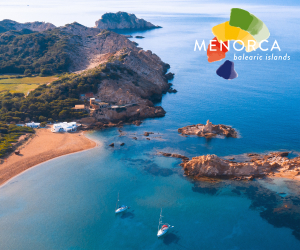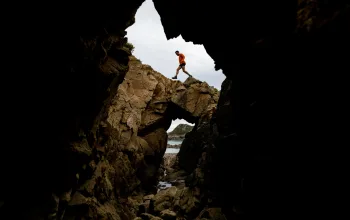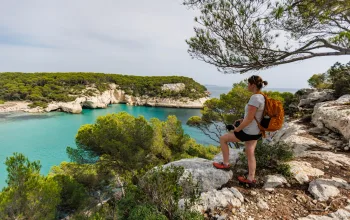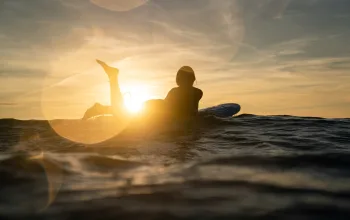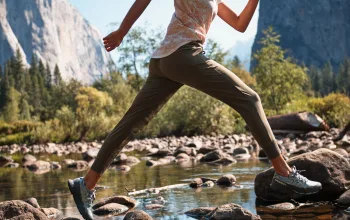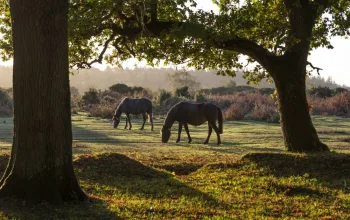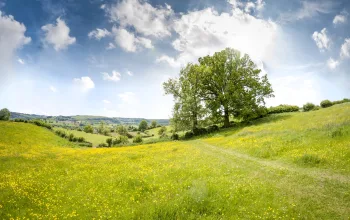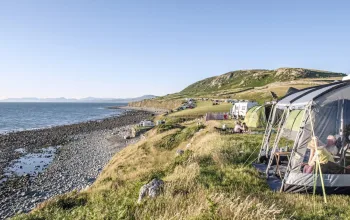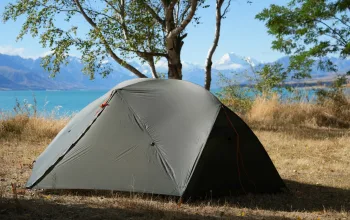The Shores of Sinai
Underwater paradise - Besides the sea, sand and sunbathing you’d be mad not to take advantage of the variety of other activities on offer. And the underwater paradise here is as good as it gets, so snorkelling or scuba diving should be top of your list.
Clear, warm waters teeming with fish, corals and shipwrecks, all just a five-hour flight from the UK – Egypt’s Sinai region remains one of the most popular destinations for Europe-based scuba divers. In the past decade both Sharm El Sheikh and its smaller neighbour, Dahab, have also seen a jump in the numbers of non-diving holiday-seekers in search of all-year sun, sea and topside adventure.
The Red Sea is the world’s northernmost tropical sea. Its waters have more than 1,000 species of fish and about 150 species of coral and a fascinating mix of shipwrecks to explore. For first-time scuba adventurer to experienced divers, the waters surrounding the southern tip of the Sinai Peninsula offer diversity in underwater topography and marine life. In Dahab, 53km north of Sharm El Sheikh, you find current-free, hassle-free diving from shore, in world-famous coral reef sites such as the Blue Hole and the Canyon. The deep waters here also bring in crowds of both free-divers and serious technical divers. Topside, Dahab is much smaller and understated than its southern neighbour Sharm so it tends to attract those looking for a more chilled-out holiday. Along Dahab’s shores there is a rich mix of coral gardens, arches, canyons and caves, with a huge mix of tropical reef fish and colourful hard and soft corals.
Sharm, by far the larger of the two resorts, has two main marinas which cater for around 120 diving centres and 400 dive boats. The best of the dive sites here are only accessible by boat. Here you will find the bigger marine life attracted by stronger currents and some of the most well-known shipwreck dives in the world. Snorkellers and non-diving partners can snorkel off the boats, or closer to home enjoy the local sites or join one of several half-day excursions.
Voted time and again the world’s best wreck dive, the SS Thistlegorm is one of the highlights of any scuba trip to the Northern Egyptian Red Sea. The 126 metre-long 4,898-tonne vessel lies virtually intact on the sea floor at a maximum depth of 30 metres.
Part of a convoy carrying military supplies for the Allied forces to North Africa in World War Two, the Thistlegorm was attacked and sunk by German bombers on 6 October 1941. The ship was carrying a vast array of cargo, including Bedford trucks, motorbikes, armoured cars – and wellies.
It takes at least two dives to explore the outside and inside of this impressive sunken time capsule which rests well within recreational scuba diving limits. The wreck is encrusted with coral and patrolled by fish life, such as grouper, moray eels, batfish, darting little orange anthias and lionfish. Its popularity does attract large underwater crowds, however, particularly during the high season between May and October. One of the best ways to explore the wreck is by liveaboard (a boat from which divers live and dive during their holiday), as these can be flexible enough to turn up in the early hours to beat the underwater crowds on the day boats.
For marine life, there are few places to beat the sites of the Ras Mohammed Marine Park. Shark and Yolanda reefs are the marine park’s highlights and are a regular feature on world ‘top dive site’ lists. The twin peaks of a single coral mount, Shark and Yolanda meet at a ‘saddle’ on the coral reef at a depth of around 25 metres. This exposed, current-fuelled site runs to depths well beyond 800 metres into the blue below. The reef is teeming with life, and healthy and vibrant colourful coral.
During the height of summer, divers can expect to see a mass of shoaling fish, such as batfish, barracuda and red snapper. Special marine encounters recorded by divers include the world’s largest fish, the whale shark, manta rays and dolphins. Shark Reef’s life-encrusted vertical wall is the easternmost part, while Yolanda’s coral garden lies to the west. It is here that the Yolanda, a Cypriot freighter, hit the reef and deposited its cargo in 1980. The shipwreck now sits at depths of more than 200 metres, while, its famous cargo of toilets and baths remains scattered along the top of the reef at accessible depths of around ten metres.
Continued...
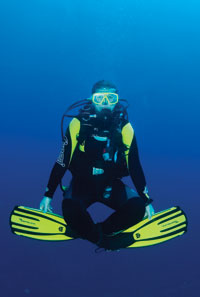 Another must-dive site is Jackson Reef, to the north near Tiran Island. Although often exposed to high winds, the reefs around the desert island attract a mass of Red Sea life. Catch the area at the right time in calm conditions and it is possible to enjoy an encounter with schooling hammerhead sharks in the blue water.
Another must-dive site is Jackson Reef, to the north near Tiran Island. Although often exposed to high winds, the reefs around the desert island attract a mass of Red Sea life. Catch the area at the right time in calm conditions and it is possible to enjoy an encounter with schooling hammerhead sharks in the blue water.
It has to be said that Sharm’s local reefs are not as spectacular as the sites of Ras Mohammed or the Strait of Tiran, however, they are excellent for new divers and photographers as they are more sheltered and can often be accessed by shore.
There are lots of dive centres in Sharm offering cheap deals, but it is worth noting that you tend to get what you pay for and that most of the smaller companies do not have their own day boats. Have a good look round first.
All the main dive companies, such as Camel Dive Club, Red Sea Diving College and Sinai Divers, all operate day boats out of Sharm. The standard of diving instruction is Egypt is generally excellent and well regulated. Divers have a choice of five-day and three-day diving packages, however, one- or two-day dive days are becoming more popular for those who do not wish to spend most of their holiday underwater.
In Dahab you can even opt for one dive a day, freeing up your morning or afternoon for other activities. As the sites around Dahab are not exposed to strong currents, they can be dived at most times of the day if the wind allows.
May to August is the high season for diving in the Red Sea. July, August and September are when sharks, such as scalloped hammerheads, are more likely to be seen. Whale sharks and manta rays appear earlier, usually from March. The large schools of snapper, jacks and barracuda on sites such as Shark and Yolanda reefs are more likely to appear in June, July and August.
If you want to avoid the crowds both underwater and topside, and avoid the intense heat of mid-summer, the best time to head to the Sinai is outside the school holidays. While the water temperature in May is generally cooler at around 23-25ºC, the air temperature in May is a more bearable 30-35ºC compared to the intense 40ºC-plus around August.
Learn to dive
The Red Sea is a great place to learn to dive. All the dive centres offer training – it takes five days to do an open water course, which involves some classroom work, learning basic skills in the pool and four open water dives. You can do the classroom and pool work in the UK and just do the open water dives in the Red Sea. Either way is relatively straight- forward and if you are a confident swimmer and fairly fit you should have no problems in gaining your certificate. You can do a try-dive or a short course, but you are better off doing the full open water certificate as this allows you to dive in other countries and resorts without any further training.
For further information contact the British Sub-Aqua Club (bsac.com) or PADI (padi.com).
Continued...
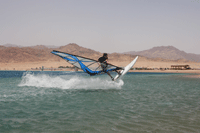 Topside
Topside
Offering the visitor everything from five-star luxury to bargain hostels, you can tailor holidays in the Egyptian Red Sea resorts of Sharm El Sheikh and Dahab to suit most budgets and interests.
On land, you can experience fine dining in cosmopolitan restaurants, party through the night in the many clubs and bars, or get away from it all in the luxury of one of Sharm El Sheikh’s many five-star hotel resorts. There is also a raft of adventure activities to experience, from windsurfing to desert trekking. Here is just a taster of what is on offer in these desert resorts…
Windsurfing
There are several beaches ideal for windsurfing and kitesurfing around the Sinai, including El Tur and Ras Sudr – little-developed areas in the Gulf of Suez. But the most popular spot for windsurfing remains Dahab. This windswept town holds an impressive record of having around 300 windy days a year. Wind speeds reach up to 33 knots. Experienced surfers are attracted by areas, such as ‘Kamikaze’ just outside the main lagoon bay of Dahab where waves can reach up to 3 metres. But there are plenty of sheltered conditions for learners. There are many windsurfing schools based along the Bedouin town’s main lagoon.
Rock climbing
Although there are great rock-climbing opportunities in the desert mountains around Dahab and Sharm, there are only a few companies which offer guided climbing excursions. Desert Divers in Dahab recently received a grant from the EU to develop tourist projects with local Bedouins in Dahab. Over the last three years, it has developed from offering one-day trips for experienced climbers to beginner and advanced courses and climbing/bouldering holidays.
desert-divers.com
Desert trips
The mountainous Sinai desert is vast. At night, the view of the stars is breathtaking and you are guaranteed to see shooting stars when gazing up from the campfire. There are a variety of tours on offer, from Bedouin dinners and star-gazing to three-day trips by camel or Jeep. To get the authentic, traditional desert experience, it is best to arrange personal tours with local Bedouins. Ask around.
Yoga
Whatever style of yoga you enjoy, Dahab is the place to go. An estimated 3,000 tourists arrived last year on pre-arranged yoga holidays. It was also one of the first places to introduce the concept of yoga diving – bringing the benefits of stretching postures and breathing exercises to scuba. The two most popular places for yoga are the Bedouin Moon hotel, where a room has been built into the mountainside for yoga. Alternatively, there are hatha and ashtanga classes regularly held at the Blue Beach Hotel.
Continued...
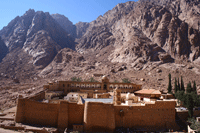 St Catherine’s
St Catherine’s
If you have a spare day during your time in the Sinai, it’s worth checking out the trips to one of the world’s oldest monasteries, St Catherine’s. Located at the foot of Mount Sinai, St Catherine’s Monastery was built by order of the Emperor Justinian between 527 and 565 AD. It was constructed around what is said to have been the burning bush seen by Moses. Many visitors to St Catherine’s also hike during the night to the summit of Mount Sinai at 2,285 metres to see the sunrise.
Horse riding
Horse riding from Sharm can be done at Sofitel and Concorde resorts. Both companies offer beach and desert rides. Concorde also has an outdoor arena for jumping and lessons. From Dahab there are also various companies offering horse riding around the desert – it is best to ask your tour operator for advice.
Quad biking
If you fancy cruising the desert on something a little faster than a camel, or only have limited time to explore this stunning landscape, there are loads of tour companies offering quad bike rides. Following-a-guide, you will be taken on a one- to two- hour trip. You don’t have to be an experienced biker and you will usually be given the option to choose between a manual and automatic quad runner. Trips are best booked for the cooler hours of around sunset when the desert mountains change colour as night begins to fall.
Images: Jane Morgan, shutterstock.com


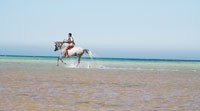 One of the biggest travel success stories of recent years has been Egypt’s Sinai region.
One of the biggest travel success stories of recent years has been Egypt’s Sinai region. 